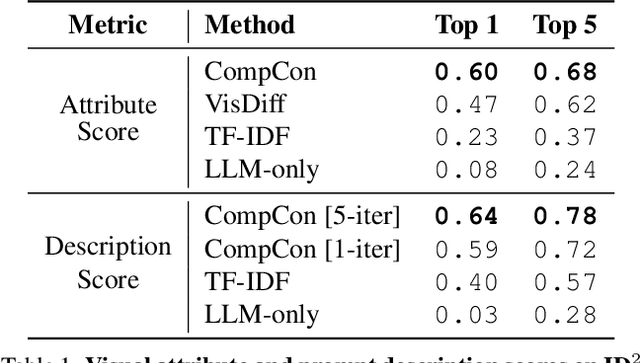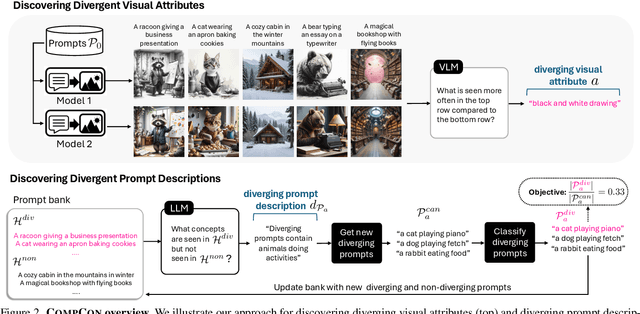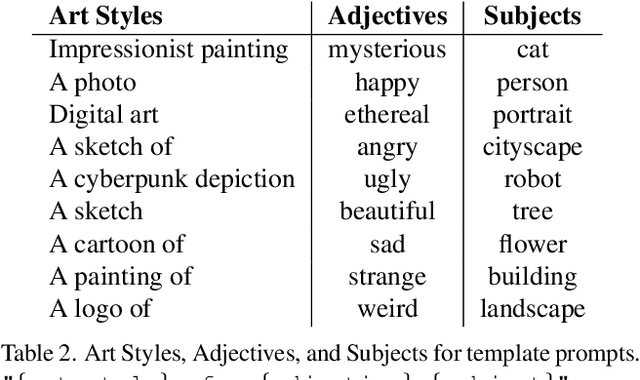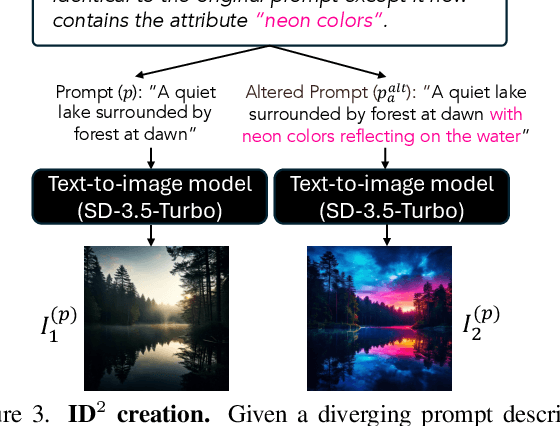Joseph E. Gonzalez
Discovering Divergent Representations between Text-to-Image Models
Sep 10, 2025



Abstract:In this paper, we investigate when and how visual representations learned by two different generative models diverge. Given two text-to-image models, our goal is to discover visual attributes that appear in images generated by one model but not the other, along with the types of prompts that trigger these attribute differences. For example, "flames" might appear in one model's outputs when given prompts expressing strong emotions, while the other model does not produce this attribute given the same prompts. We introduce CompCon (Comparing Concepts), an evolutionary search algorithm that discovers visual attributes more prevalent in one model's output than the other, and uncovers the prompt concepts linked to these visual differences. To evaluate CompCon's ability to find diverging representations, we create an automated data generation pipeline to produce ID2, a dataset of 60 input-dependent differences, and compare our approach to several LLM- and VLM-powered baselines. Finally, we use CompCon to compare popular text-to-image models, finding divergent representations such as how PixArt depicts prompts mentioning loneliness with wet streets and Stable Diffusion 3.5 depicts African American people in media professions. Code at: https://github.com/adobe-research/CompCon
LEANN: A Low-Storage Vector Index
Jun 09, 2025Abstract:Embedding-based search is widely used in applications such as recommendation and retrieval-augmented generation (RAG). Recently, there is a growing demand to support these capabilities over personal data stored locally on devices. However, maintaining the necessary data structure associated with the embedding-based search is often infeasible due to its high storage overhead. For example, indexing 100 GB of raw data requires 150 to 700 GB of storage, making local deployment impractical. Reducing this overhead while maintaining search quality and latency becomes a critical challenge. In this paper, we present LEANN, a storage-efficient approximate nearest neighbor (ANN) search index optimized for resource-constrained personal devices. LEANN combines a compact graph-based structure with an efficient on-the-fly recomputation strategy to enable fast and accurate retrieval with minimal storage overhead. Our evaluation shows that LEANN reduces index size to under 5% of the original raw data, achieving up to 50 times smaller storage than standard indexes, while maintaining 90% top-3 recall in under 2 seconds on real-world question answering benchmarks.
Search Arena: Analyzing Search-Augmented LLMs
Jun 05, 2025Abstract:Search-augmented language models combine web search with Large Language Models (LLMs) to improve response groundedness and freshness. However, analyzing these systems remains challenging: existing datasets are limited in scale and narrow in scope, often constrained to static, single-turn, fact-checking questions. In this work, we introduce Search Arena, a crowd-sourced, large-scale, human-preference dataset of over 24,000 paired multi-turn user interactions with search-augmented LLMs. The dataset spans diverse intents and languages, and contains full system traces with around 12,000 human preference votes. Our analysis reveals that user preferences are influenced by the number of citations, even when the cited content does not directly support the attributed claims, uncovering a gap between perceived and actual credibility. Furthermore, user preferences vary across cited sources, revealing that community-driven platforms are generally preferred and static encyclopedic sources are not always appropriate and reliable. To assess performance across different settings, we conduct cross-arena analyses by testing search-augmented LLMs in a general-purpose chat environment and conventional LLMs in search-intensive settings. We find that web search does not degrade and may even improve performance in non-search settings; however, the quality in search settings is significantly affected if solely relying on the model's parametric knowledge. We open-sourced the dataset to support future research in this direction. Our dataset and code are available at: https://github.com/lmarena/search-arena.
Sleep-time Compute: Beyond Inference Scaling at Test-time
Apr 17, 2025Abstract:Scaling test-time compute has emerged as a key ingredient for enabling large language models (LLMs) to solve difficult problems, but comes with high latency and inference cost. We introduce sleep-time compute, which allows models to "think" offline about contexts before queries are presented: by anticipating what queries users might ask and pre-computing useful quantities, we can significantly reduce the compute requirements at test-time. To demonstrate the efficacy of our method, we create modified versions of two reasoning tasks - Stateful GSM-Symbolic and Stateful AIME. We find that sleep-time compute can reduce the amount of test-time compute needed to achieve the same accuracy by ~ 5x on Stateful GSM-Symbolic and Stateful AIME and that by scaling sleep-time compute we can further increase accuracy by up to 13% on Stateful GSM-Symbolic and 18% on Stateful AIME. Furthermore, we introduce Multi-Query GSM-Symbolic, which extends GSM-Symbolic by including multiple related queries per context. By amortizing sleep-time compute across related queries about the same context using Multi-Query GSM-Symbolic, we can decrease the average cost per query by 2.5x. We then conduct additional analysis to understand when sleep-time compute is most effective, finding the predictability of the user query to be well correlated with the efficacy of sleep-time compute. Finally, we conduct a case-study of applying sleep-time compute to a realistic agentic SWE task.
Generate, but Verify: Reducing Hallucination in Vision-Language Models with Retrospective Resampling
Apr 17, 2025Abstract:Vision-Language Models (VLMs) excel at visual understanding but often suffer from visual hallucinations, where they generate descriptions of nonexistent objects, actions, or concepts, posing significant risks in safety-critical applications. Existing hallucination mitigation methods typically follow one of two paradigms: generation adjustment, which modifies decoding behavior to align text with visual inputs, and post-hoc verification, where external models assess and correct outputs. While effective, generation adjustment methods often rely on heuristics and lack correction mechanisms, while post-hoc verification is complicated, typically requiring multiple models and tending to reject outputs rather than refine them. In this work, we introduce REVERSE, a unified framework that integrates hallucination-aware training with on-the-fly self-verification. By leveraging a new hallucination-verification dataset containing over 1.3M semi-synthetic samples, along with a novel inference-time retrospective resampling technique, our approach enables VLMs to both detect hallucinations during generation and dynamically revise those hallucinations. Our evaluations show that REVERSE achieves state-of-the-art hallucination reduction, outperforming the best existing methods by up to 12% on CHAIR-MSCOCO and 28% on HaloQuest. Our dataset, model, and code are available at: https://reverse-vlm.github.io.
Bandwidth Allocation for Cloud-Augmented Autonomous Driving
Mar 26, 2025Abstract:Autonomous vehicle (AV) control systems increasingly rely on ML models for tasks such as perception and planning. Current practice is to run these models on the car's local hardware due to real-time latency constraints and reliability concerns, which limits model size and thus accuracy. Prior work has observed that we could augment current systems by running larger models in the cloud, relying on faster cloud runtimes to offset the cellular network latency. However, prior work does not account for an important practical constraint: limited cellular bandwidth. We show that, for typical bandwidth levels, proposed techniques for cloud-augmented AV models take too long to transfer data, thus mostly falling back to the on-car models and resulting in no accuracy improvement. In this work, we show that realizing cloud-augmented AV models requires intelligent use of this scarce bandwidth, i.e. carefully allocating bandwidth across tasks and providing multiple data compression and model options. We formulate this as a resource allocation problem to maximize car utility, and present our system \sysname which achieves an increase in average model accuracy by up to 15 percentage points on driving scenarios from the Waymo Open Dataset.
Why Do Multi-Agent LLM Systems Fail?
Mar 17, 2025Abstract:Despite growing enthusiasm for Multi-Agent Systems (MAS), where multiple LLM agents collaborate to accomplish tasks, their performance gains across popular benchmarks remain minimal compared to single-agent frameworks. This gap highlights the need to analyze the challenges hindering MAS effectiveness. In this paper, we present the first comprehensive study of MAS challenges. We analyze five popular MAS frameworks across over 150 tasks, involving six expert human annotators. We identify 14 unique failure modes and propose a comprehensive taxonomy applicable to various MAS frameworks. This taxonomy emerges iteratively from agreements among three expert annotators per study, achieving a Cohen's Kappa score of 0.88. These fine-grained failure modes are organized into 3 categories, (i) specification and system design failures, (ii) inter-agent misalignment, and (iii) task verification and termination. To support scalable evaluation, we integrate MASFT with LLM-as-a-Judge. We also explore if identified failures could be easily prevented by proposing two interventions: improved specification of agent roles and enhanced orchestration strategies. Our findings reveal that identified failures require more complex solutions, highlighting a clear roadmap for future research. We open-source our dataset and LLM annotator.
WorldModelBench: Judging Video Generation Models As World Models
Feb 28, 2025Abstract:Video generation models have rapidly progressed, positioning themselves as video world models capable of supporting decision-making applications like robotics and autonomous driving. However, current benchmarks fail to rigorously evaluate these claims, focusing only on general video quality, ignoring important factors to world models such as physics adherence. To bridge this gap, we propose WorldModelBench, a benchmark designed to evaluate the world modeling capabilities of video generation models in application-driven domains. WorldModelBench offers two key advantages: (1) Against to nuanced world modeling violations: By incorporating instruction-following and physics-adherence dimensions, WorldModelBench detects subtle violations, such as irregular changes in object size that breach the mass conservation law - issues overlooked by prior benchmarks. (2) Aligned with large-scale human preferences: We crowd-source 67K human labels to accurately measure 14 frontier models. Using our high-quality human labels, we further fine-tune an accurate judger to automate the evaluation procedure, achieving 8.6% higher average accuracy in predicting world modeling violations than GPT-4o with 2B parameters. In addition, we demonstrate that training to align human annotations by maximizing the rewards from the judger noticeably improve the world modeling capability. The website is available at https://worldmodelbench-team.github.io.
S*: Test Time Scaling for Code Generation
Feb 20, 2025Abstract:Increasing test-time compute for LLMs shows promise across domains but remains underexplored in code generation, despite extensive study in math. In this paper, we propose S*, the first hybrid test-time scaling framework that substantially improves the coverage and selection accuracy of generated code. S* extends the existing parallel scaling paradigm with sequential scaling to push performance boundaries. It further leverages a novel selection mechanism that adaptively generates distinguishing inputs for pairwise comparison, combined with execution-grounded information to robustly identify correct solutions. We evaluate across 12 Large Language Models and Large Reasoning Model and show: (1) S* consistently improves performance across model families and sizes, enabling a 3B model to outperform GPT-4o-mini; (2) S* enables non-reasoning models to surpass reasoning models - GPT-4o-mini with S* outperforms o1-preview by 3.7% on LiveCodeBench; (3) S* further boosts state-of-the-art reasoning models - DeepSeek-R1-Distill-Qwen-32B with S* achieves 85.7% on LiveCodeBench, approaching o1 (high) at 88.5%. Code will be available under https://github.com/NovaSky-AI/SkyThought.
Autellix: An Efficient Serving Engine for LLM Agents as General Programs
Feb 19, 2025Abstract:Large language model (LLM) applications are evolving beyond simple chatbots into dynamic, general-purpose agentic programs, which scale LLM calls and output tokens to help AI agents reason, explore, and solve complex tasks. However, existing LLM serving systems ignore dependencies between programs and calls, missing significant opportunities for optimization. Our analysis reveals that programs submitted to LLM serving engines experience long cumulative wait times, primarily due to head-of-line blocking at both the individual LLM request and the program. To address this, we introduce Autellix, an LLM serving system that treats programs as first-class citizens to minimize their end-to-end latencies. Autellix intercepts LLM calls submitted by programs, enriching schedulers with program-level context. We propose two scheduling algorithms-for single-threaded and distributed programs-that preempt and prioritize LLM calls based on their programs' previously completed calls. Our evaluation demonstrates that across diverse LLMs and agentic workloads, Autellix improves throughput of programs by 4-15x at the same latency compared to state-of-the-art systems, such as vLLM.
 Add to Chrome
Add to Chrome Add to Firefox
Add to Firefox Add to Edge
Add to Edge